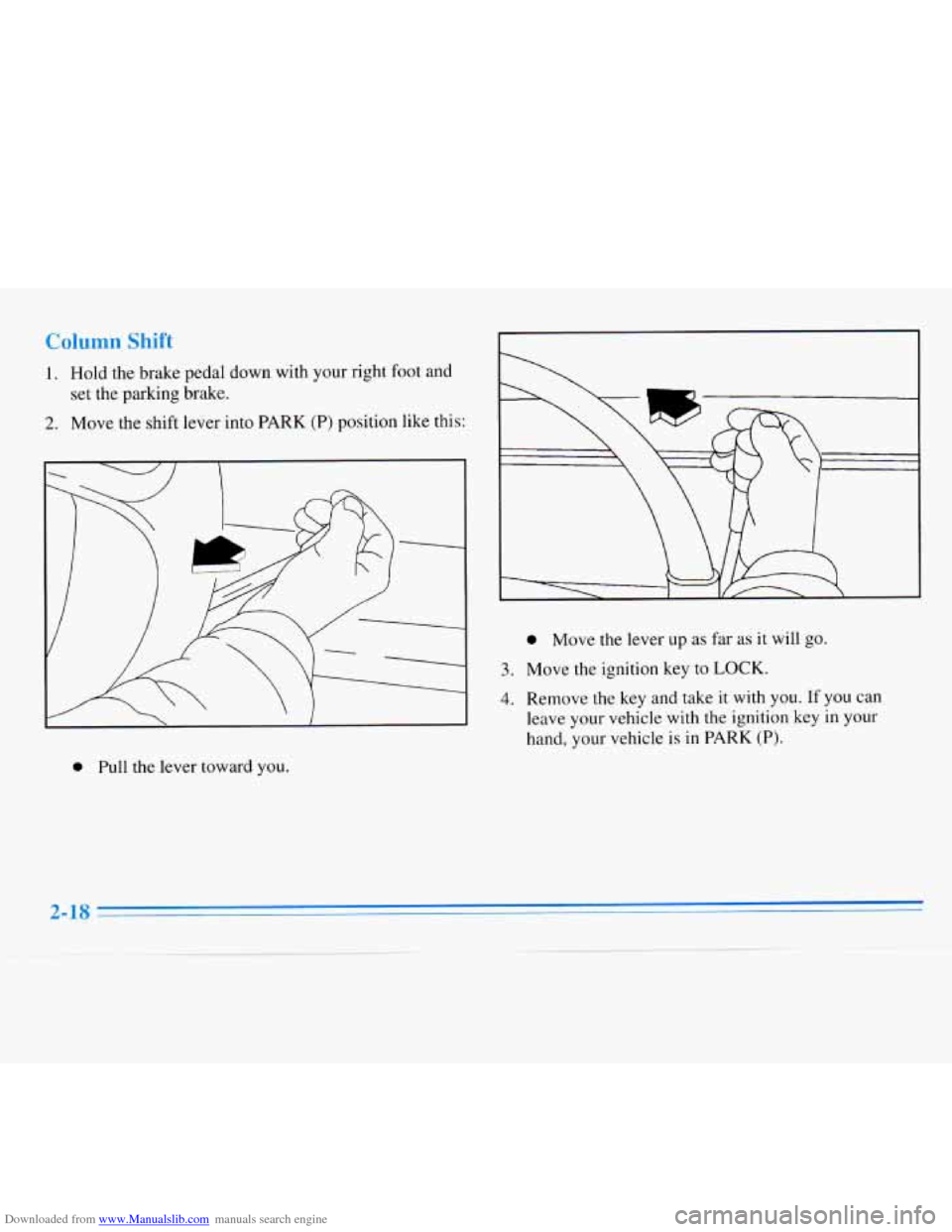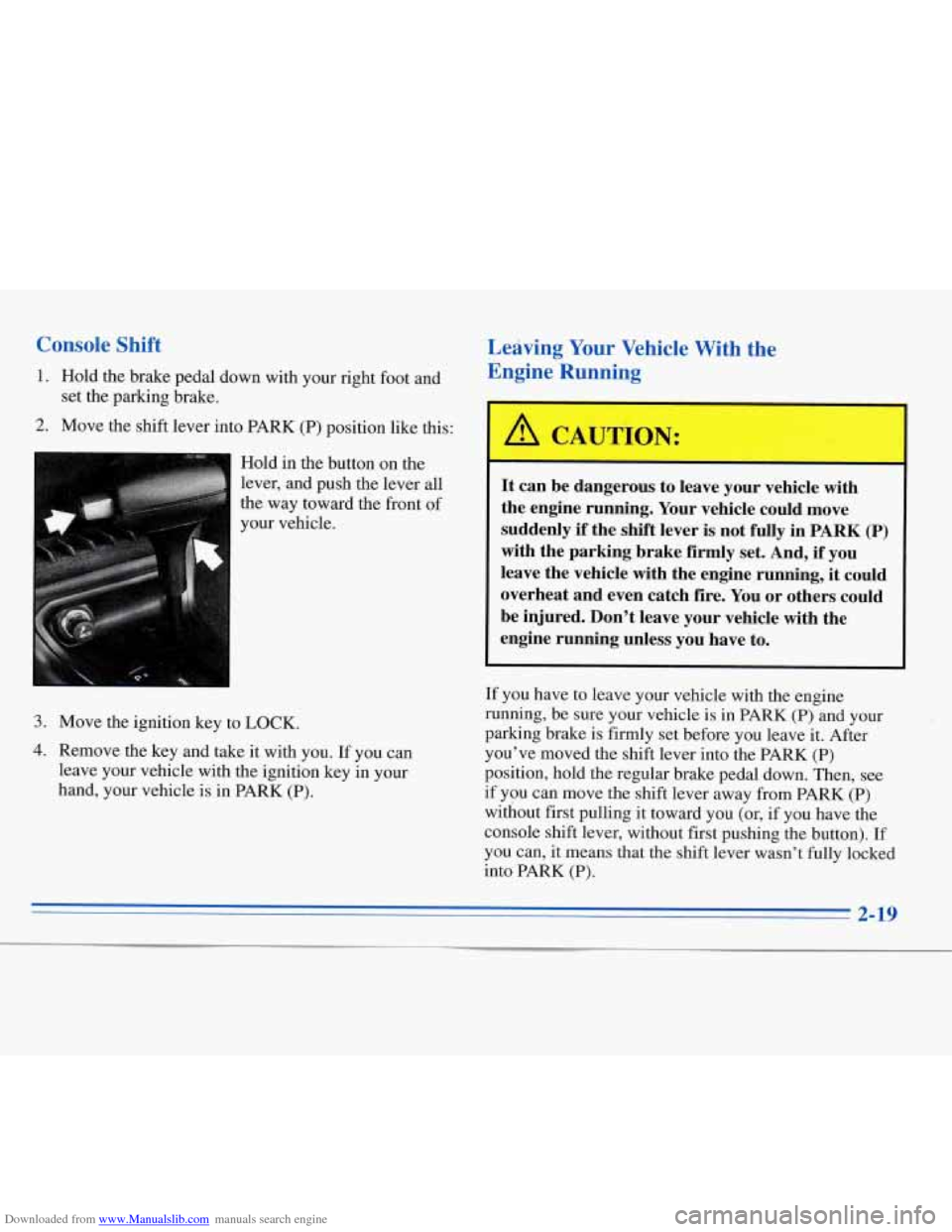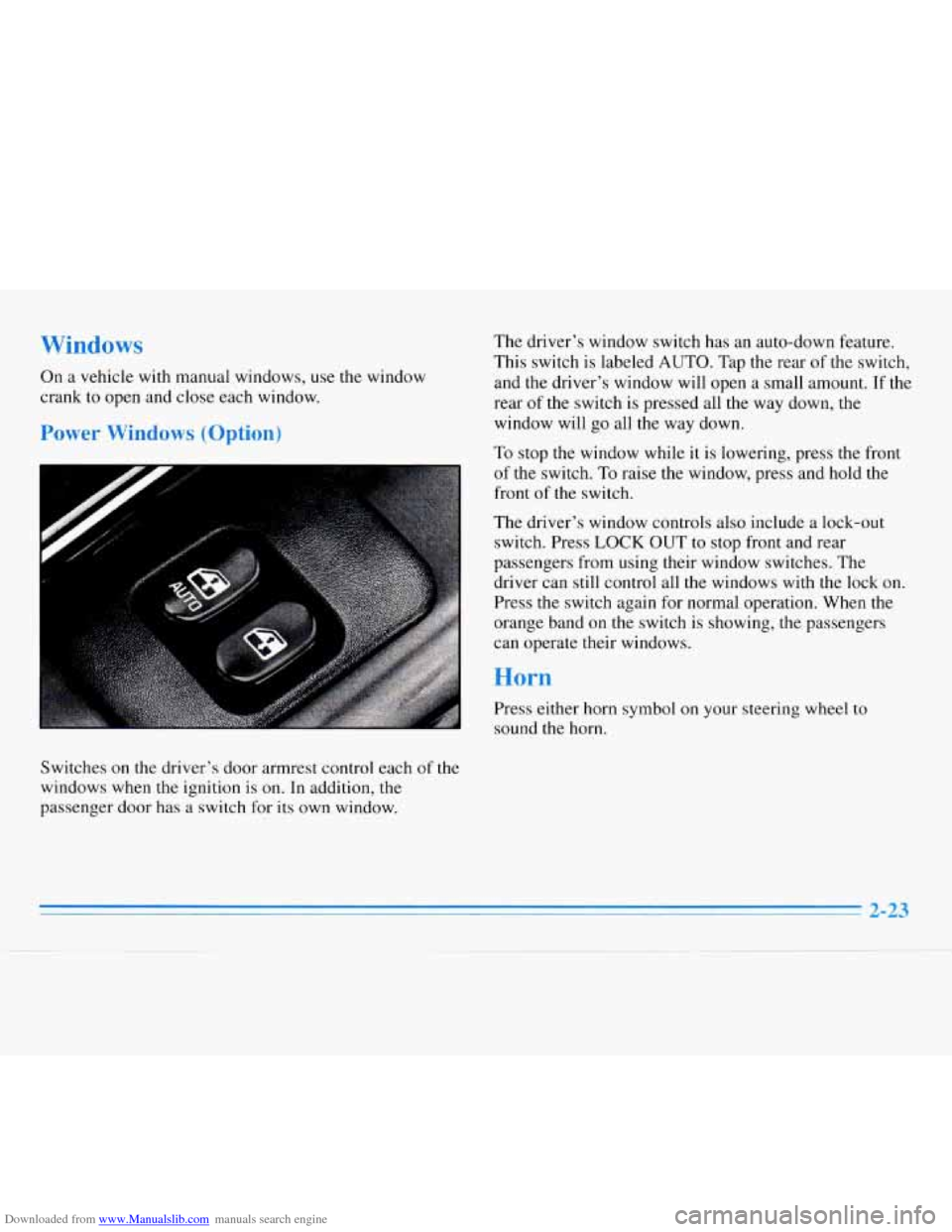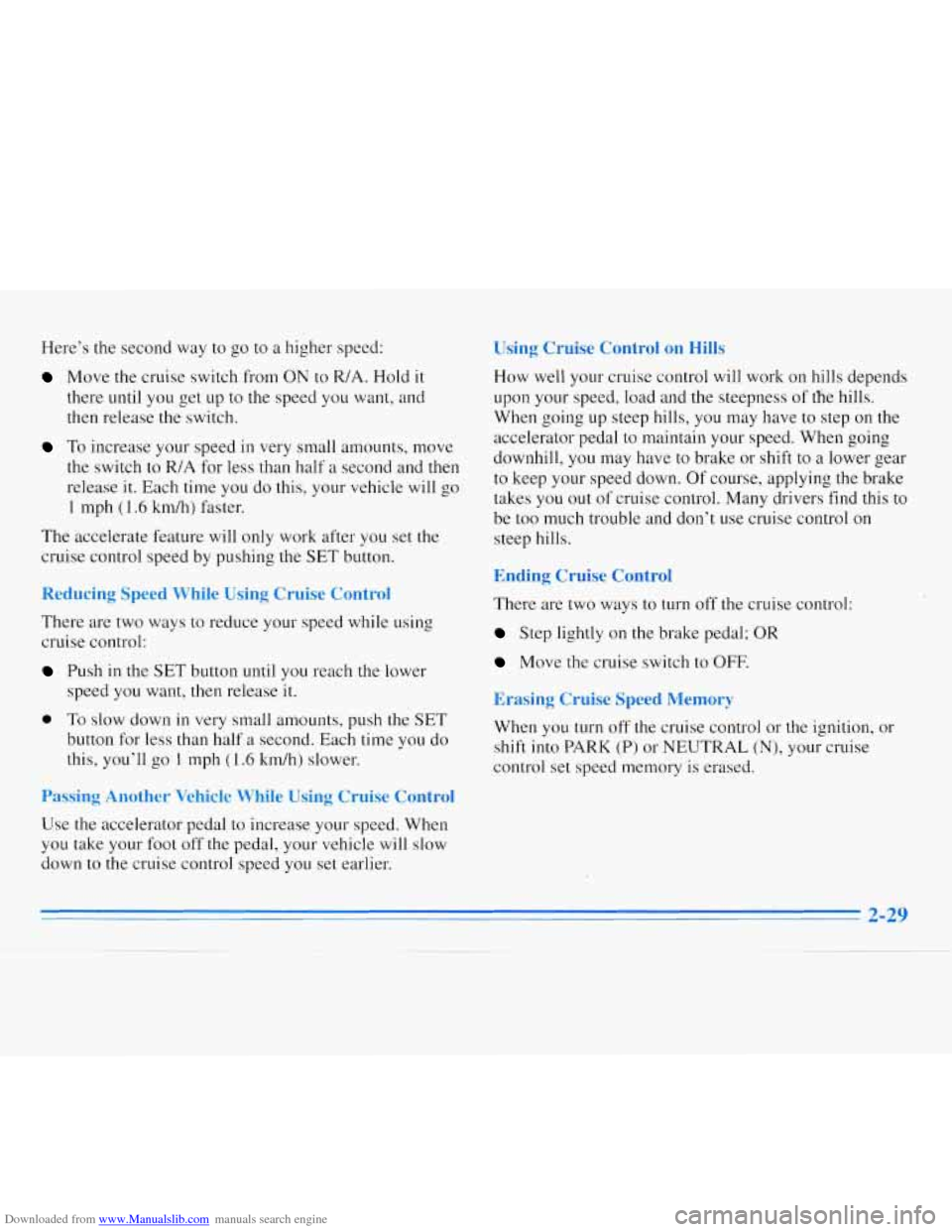1996 CHEVROLET MONTE CARLO ignition
[x] Cancel search: ignitionPage 71 of 340

Downloaded from www.Manualslib.com manuals search engine Automatic Transaxle Operation
-I
Your automatic transaxle may have a shift lever on the
steering column or on the console between the seats.
Maximum engine speed
is limited on automatic
transaxle vehicles, when you’re
in PARK (P) or
NEUTRAL (N), to protect driveline components from
improper operation.
There are several different positions for your shift lever.
PARK (P): This locks your front wheels. It’s the best
position to use when
you start your engine because your
vehicle can’t move easily.
It is dangerous to get out of your vehicle if the
shift lever
is not fully in PARK (P) with the
parking brake firmly set. Your vehicle can
roll.
Don’t leave your vehicle when the engine is
running unless you have to.
‘If you have left the
engine running, the vehicle can move suddenly.
You
or others could be injured. To be sure your
vehicle won’t move, even when you’re on fairly
level ground, always set your parking brake and
move the shift lever to
PARK (P).
See (‘Shifting Into PARK (P)” in the Index. If
you’re pulling a trailer, see “Towing a Trailer” in
the Index.
Make sure the shift lever is fully into PARK (P) range
before starting the engine. Your Chevrolet has
a
brake-transaxle shift interlock. You must fully apply
your regular brakes before you can shift from PARK (P)
when the ignition is
in RUN. If you cannot shift out of
PARK (P), ease pressure on the shift lever by pushing it
all the way into PARK (P) while keeping the brake pedal
- 2-13
Page 76 of 340

Downloaded from www.Manualslib.com manuals search engine Column Shift
1. Hold the brake pedal down with your right foot and
2. Move the shift lever into PARK (P) position like this:
set the parking brake.
r
0 Move the lever up as far as it will go.
3. Move the ignition key to LOCK.
4. Remove the key and take it with you. If you can
leave
your vehicle with the ignition key in your
hand, your vehicle is in PARK (P).
0 Pull the lever toward you.
2-18
Page 77 of 340

Downloaded from www.Manualslib.com manuals search engine Console Shift
1. Hold the brake pedal down with your right foot and
2. Move the shift lever into PARK (P) position like this:
set the parking brake.
Hold in the button on the
lever, and push the lever all
the way toward the front of
your vehicle.
3. Move the ignition key to LOCK.
I , 4. Remove the key and take it with you. If you can
leave your vehicle with the ignition key in your
hand, your vehicle is in PARK (P).
Leaving Your Vehicle With the
Engine Running
It can be dangerous to leave your vehicle with
the engine running. Your vehicle could move
suddenly
if the shift lever is not fully in PARK (P)
with the parking brake firmly set. And, if you
leave the vehicle with the engine running, it could
overheat and even catch fire.
You or others could
be injured. Don’t leave your vehicle with the
engine running unless you have to.
If you have to leave your vehicle with the engine
running, be sure your vehicle is in
PARK (P) and your
parking brake is firmly set before you leave it. After
you’ve moved the shift lever into the PARK
(P)
position, hold the regular brake pedal down. Then, see
if you can move the shift lever away from PARK
(P)
without first pulling it toward you (or, if you have the
console shift lever, without first pushing the button). If
you can,
it means that the shift lever wasn’t fully locked
into PARK
(P).
2-19
Page 78 of 340

Downloaded from www.Manualslib.com manuals search engine If you are parking on a hill and you don’t shift your
transaxle into PARK
(P) properly, the weight of the
vehicle may
put too much force on the parking pawl in
the transaxle. You may find it difficult to pull the shift
lever
out of PARK (P). This is called “torque lock.” To
prevent torque lock, set the parking brake and then
shift
into PARK (P) properly before you leave the driver’s
seat.
To find out how, see “Shifting Into PARK (P)”
in the Index.
When
you are ready to drive, move the shift lever out of
PARK (P)
before you release the parking brake.
If torque lock does occur, you may need to have another
vehicle
push yours a little uphill to take some of the
pressure from the transaxle,
so you can pull the shift
lever out of PARK (P). Your
Chevrolet has
a brake-transaxle shift interlock.
You must fully apply your regular brakes before you can
shift from PARK (P) when the ignition is in RUN. See
“Automatic Transaxle Operation” in the Index.
If you cannot shift out of PARK (P), ease pressure on
the shift lever by pushing it all the way into PARK (P)
while keeping the brake pedal pushed down. Release the
shift lever button if you have
a console shift. Then move
the shift lever out of PARK
(P), being sure to press the
shift lever button
if you have a console shift.
If you ever hold the brake pedal down but still can’t
shift out of PARK (P), try this:
1. Turn the key to OFF.
2. Apply and hold the brake until the end of Step 4.
3. Shift to NEUTRAL (N).
4. Start the engine and shift to the drive gear you want.
5. Have the vehicle fixed as soon as you can.
Page 81 of 340

Downloaded from www.Manualslib.com manuals search engine On a vehicle with manual windows, use the window
crank
to open and close each window.
Switches
on the driver’s door armrest control each of the
windows when the ignition is on. In addition,
the
passenger door has a switch for its own window. The
driver’s window switch has an auto-down feature.
This switch
is labeled AUTO. Tap the rear of the switch,
and the driver’s window will open a small amount. If the
rear of the switch
is pressed all the way down, the
window will go all the way down.
To stop the window while it is lowering, press the front
of the switch. To raise the window, press and hold the
front of the switch.
The driver’s window controls also include a lock-out
switch. Press
LOCK OUT to stop front and rear
passengers from using their window switches. The
driver can still control all
the windows with the lock on.
Press the switch again for normal operation. When the
orange band on
the switch is showing, the passengers
can operate their windows.
’Torn
Press either horn symbol on your steering wheel to
sound the horn.
Page 87 of 340

Downloaded from www.Manualslib.com manuals search engine Here’s the second way to go to a higher speed:
Move the cruise switch from ON to R/A. Hold it
there until
you get up to the speed you want, and
then release the switch.
To increase your speed in very small amounts, move
the switch to
R/A for less than half a second and then
release it. Each time you do this, your vehicle will go
1 mph (1.6 km/h) faster.
The accelerate feature will only work after you set
the
cruise control speed by pushing the SET button.
Reducing Speed While Using Cruise Control
There are two ways to reduce your speed while using
cruise control:
Push in the SET button until you reach the lower
speed you want,
then release it.
0 To slow down in very small amounts, push the SET
button for less than half a second. Each time you do
this, you’ll go 1 mph (1.6 km/h) slower.
Using Cruise Control on Hills
How well your cruise control will work on hills depends
upon your speed, load and the steepness of tfie hills.
When going up steep hills, you may have to step on the
accelerator pedal
to maintain your speed. When going
downhill, you may have to brake or shift
to a lower gear
to keep your speed down. Of course, applying the brake
takes you out of cruise control. Many drivers find this to
be too much trouble and don’t use cruise control
on
steep hills.
Ending Cruise Control
There are two ways to turn off the cruise control:
Step lightly on the brake pedal; OR
Move the cruise switch to OFF.
Erasing Cruise Speed Memory
When you turn off the cruise control or the ignition, or
shift
into PARK (P) or NEUTRAL (N), your cruise
control set speed memory is erased.
Passing Another Vehicle While Using Cruise Control
Use the accelerator pedal to increase your speed. When
you take your foot
off the pedal, your vehicle will slow
down to the cruise control speed you set earlier.
2-29
Page 88 of 340

Downloaded from www.Manualslib.com manuals search engine Lamps
The lamp controls are on the instrument panel. They
control these systems:
Headlamps
Taillamps
0 Parking Lamps
License Lamps
0 Sidemarker Lamps
0 Instrument Panel Lamps
0 Courtesy Lamps
-g- Turn the knob to this symbol (C) to turn on the
headlamps and other operating lamps.
pf Turn the knob to this symbol (B) to turn on the
parking and other operating lamps without the
headlamps.
Turn the knob to
OFF to turn off the lamps.
A warning chime will sound when you turn
the ignition
switch to
OFF, LOCK or ACC with the lamps on.
"time Ru: ling Lamps (Canada Only)
mytime Running Lamps (DRL) can make it easier
for others to see the front of your vehicle during the
day.
DRL can be helpful in many different driving
conditions, but they can be especially helpful
in the
short periods after dawn and before sunset.
A light sensor on top of the instrument panel makes the
DRL work,
so be sure it isn't covered.
The DRL system will make your low-beam headlamps
come on
at a reduced brightness when:
0 The ignition is on,
0 The headlamp switch is off, and
0 The parking brake is released.
2-30
Page 89 of 340

Downloaded from www.Manualslib.com manuals search engine When the DRL are on, only your low-beam headlamps
will be on. The taillamps, sidemarker and other lamps
won’t be on. Your instrument panel won’t be lit
up either.
When it’s dark enough outside, your low-beam
headlamps will change to
full brightness. The other
lamps that come
on with your headlamps will also
come on.
When it’s bright enough outside, the regular lamps will
go out, and your low-beam headlamps change to the
reduced brightness of DRL.
To idle your vehicle with the DRL off, set the parking
brake while the ignition is
in OFF or LOCK. Then start
your vehicle. The DRL will stay off
until you release the
parking brake.
As with any vehicle, you should turn on the regular
headlamp system when you need
it.
Interior Lamps
Instrument Panel Brightness Control
You can brighten or dim the instrument panel lamps by
moving the dial
(A). If you turn the dial all the way up,
your courtesy or interior lamps will come on.
Courtesy Lamps
When any door is opened, several lamps come on. These
lamps are courtesy lamps. They make
it easy for you to
enter and leave your vehicle. You can also turn these
lamps on by moving the dial near the headlamp knob
all the way up.
Some of the lamps have switches so you can turn them
on,
even when the doors are closed. These lamps are
reading lamps. To avoid draining your battery, be sure
to turn off all reading lamps when leaving your vehicle.
2-31
._